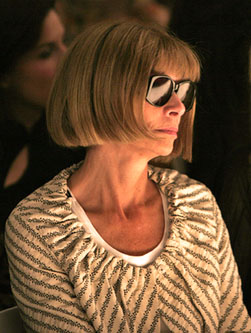 |
| Anna Wintour at the 2005 New York Fall Fashion Week (Karin Bar). |
Anna Wintour has been the editor-in-chief of Vogue since 1988. She's been a constant in a world of passing trends, so much that her influence goes beyond the magazine itself.
Wintour was a real up and comer on various publications prior to joining the US edition of Vogue, and she was eventually used to take over and radically change Condé Nast magazines such as House & Garden and the UK edition of Vogue.
Even before working at Condé Nast, when previous Vogue editor Grace Mirabella asked Wintour what her dream job was during an interview, Wintour reportedly said, "Yours."
After her time at House & Garden, Wintour fulfilled that dream and succeeded Mirabella as Vogue's editor.
Wintour revamped the magazine by using less well-known models, mixing inexpensive clothes with high fashion, and changing the cover style from tight headshots taken indoors to outdoor shots that showed more of the body.
The best example of this change is seen in the first issue she published in November 1988, seen below. The cover shows 19-year-old model Michaela Bercu in a $50 pair of jeans and a $10,000 designer jacket.
 |
| Cover of the November 1988 issue of Vogue (Style). |
Likewise, Wintour has inspired a variety of other aspects of pop culture. Namely, she is reportedly the inspiration for Miranda Priestly in "The Devil Wears Prada," Edna Mode in "The Incredibles," Fey Sommers in "Ugly Betty," and even Willy Wonka in 2005's "Charlie and the Chocolate Factory."
One way or another, Anna Wintour is synonymous with Vogue and the high fashion industry.
No comments:
Post a Comment